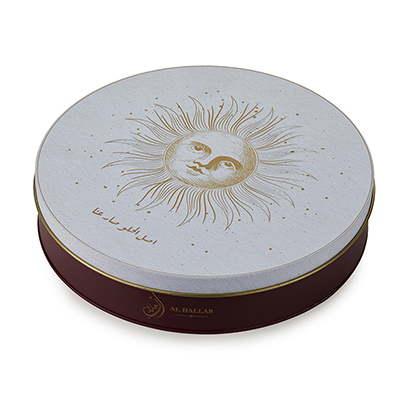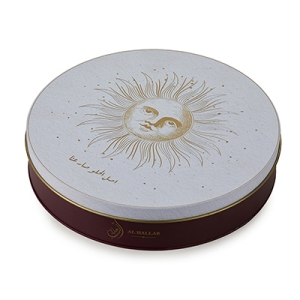Leading Innovations in Chocolate Tin Manufacturer
Chocolate Tin Manufacturer – Leading Innovations in Chocolate Tin Box Design and Production
Chocolate tin manufacturers play a pivotal role in the packaging and presentation of one of the world’s favorite confections. The industry’s expertise in crafting chocolate tins, which are metal containers designed specifically for chocolate storage and gift presentation, has a significant impact on the marketability of chocolate products. These tins, often made of tinplate or aluminum, provide durable and protective enclosures that maintain the freshness and flavor of the chocolate, while also offering an attractive aesthetic.
Chocolate tin boxes serve a dual purpose: they are practical for ensuring the quality of the product, and they can also be ornate, making them collectible items long after the chocolates are consumed. As consumers increasingly seek high-quality and luxuriously packaged chocolates, the demand for beautifully designed tins has grown. The design and manufacture of these tins require precision and creativity, as they often feature intricate embossing, customized shapes, and colorful prints that reflect the brand’s identity and the occasion for which they are intended.
Manufacturers of these tins must keep abreast of industry trends and consumer preferences to create packaging that stands out in a competitive market. They must balance functionality with design flair, producing chocolate tins that not only protect and preserve the products inside but also enhance the overall customer experience. This combination of practicality and visual appeal makes chocolate tins an essential component in the presentation and marketing of chocolates.
History of Chocolate Tins
The history of chocolate tins is characterized by innovative manufacturing techniques and significant milestones that have transformed packaging and distribution of chocolate.
Evolution of Chocolate Tin Manufacturing
In the early 19th century, chocolate was primarily sold in bulk or in simple paper packaging. The advent of tinplate—thin sheets of steel coated with tin—revolutionized the chocolate industry. Chocolate tins were first produced on a large scale in the late 1800s, following the industrialization of the tinplate manufacturing. The introduction of automatic can-making machinery in the early 20th century further streamlined the production of chocolate tins, allowing for the mass production of consistent and durable packaging. This also coincided with the burgeoning popularity of chocolate as a consumer indulgence, leading to increased demand for high-quality, attractive, and long-lasting containers.
Significant Milestones in Chocolate Tin Development
- Late 1800s: Introduction of lithography on metal, allowing for colorful and intricate designs on chocolate tins, which enhanced brand appeal and consumer desire.
- Early 1900s: Adoption of double seaming techniques improved the airtight seal of tins, preserving the quality and flavor of chocolate during storage and transport.
- Mid-20th century: The shift to easier-to-open packaging solutions, such as slip lids and hinged covers, provided greater convenience for consumers.
- In recent years, environmental considerations have prompted a shift toward the use of recycled materials and more sustainable production processes in the manufacturing of chocolate tins.
Types of Chocolate Tins
Chocolate tins come in various forms, each serving a different purpose and audience. Whether it’s the classic appeal of standard tins or the unique touch of custom options, chocolate tins cater to myriad packaging needs. Seasonal variations further diversify this range, often becoming collectibles.
Standard Chocolate Tins
Standard chocolate tins are the industry’s go-to solution for durability and classic design. Typically rectangular or cylindrical, these tins are made from metal and come in common sizes. They are stackable, which makes them convenient for both transport and display.
Manufacturers often produce them in bulk with pre-designed patterns or solid colors. Their sizes range to accommodate different quantities, frequently seen as:
- Small (50-150g)
- Medium (150-250g)
- Large (250g and above)
Custom Chocolate Tins
Custom chocolate tins offer a personalized touch, allowing brands to stand out on the shelves. Manufacturers provide services to tailor-make tins to specific shapes, sizes, and designs. Here, the possibilities are nearly endless, with the option to emboss logos, print high-quality images, or use unique color schemes for brand recognition.
Options for customization typically include:
- Shape: Hearts, stars, bespoke shapes
- Size: From bite-size to family-sized tins
- Design: Thematic imagery, brand-centric artwork
Seasonal Chocolate Tins
Seasonal chocolate tins are released in limited editions to celebrate various holidays and occasions. They often feature festive designs and are sought after by collectors and gift-givers alike. Common themes include Christmas, Easter, Valentine’s Day, and Halloween, each with its distinct aesthetic.
Seasonal tins can be found in shapes and designs such as:
- Christmas: Trees, ornaments, Santa Claus motifs
- Easter: Eggs, bunnies, pastel colors
- Valentine’s Day: Hearts, roses, love-inspired artwork
Manufacturing Process
The manufacturing process of chocolate tins involves a sequence of clearly defined steps, from initial design stages to the selection of appropriate materials and the application of advanced production techniques. These steps ensure the production of high-quality and durable chocolate tin boxes that meet industry standards.
Design and Prototyping
In the design phase, manufacturers create detailed blueprints of the chocolate tin, often using computer-aided design (CAD) software. This facilitates precision and efficiency in production. Prototyping follows; a sample tin is produced to evaluate the design’s functionality and aesthetic appeal.
Material Selection
Selecting the right material is crucial for the durability and quality of the chocolate tin. Manufacturers typically opt for food-grade tinplate, which offers corrosion resistance, non-toxicity, and suitability for direct contact with food products.
Production Techniques
Various production techniques are employed to transform materials into finished chocolate tin boxes. This includes:
- Cutting: Precision tools cut the tinplate to the required size.
- Forming: Through stamping or pressing, the cut tinplate is shaped into the box design.
- Joining: Components are assembled using techniques like welding or crimping to ensure a tight seal.
- Finishing: The tins are printed and varnished to provide an attractive and protective coating.
Each step is carried out with strict quality control to ensure consistency and excellence in the final product.
Design and Customization
When selecting a chocolate tin manufacturer, design and customization are pivotal considerations. These features distinguish products in a crowded market and cater to specific client needs.
Branding and Theming
Branding is a cornerstone of design, allowing for the alignment of chocolate tins with corporate identity. Manufacturers offer a variety of customizations:
- Logos and Brand Colors: Using advanced printing techniques to accurately match brand palettes.
- Thematic Designs: Crafting tins for seasonal promotions or specific events, enhancing brand visibility.
Unique Shapes and Sizes
Chocolate tins come in an array of shapes and sizes, catering to diverse packaging requirements:
- Sizes: Ranging from small, individual-portion tins to large, family-sized containers.
- Shapes: Offering standard shapes like circles and rectangles, as well as novelty options such as hearts or custom silhouettes.
Innovations in Tin Artwork
Tin artwork is undergoing constant innovation, pushing the boundaries of traditional designs:
- Embossing and Debossing: Creating a tactile experience that visually elevates the product.
- Metallic Inks and Finishes: Utilizing materials that give a premium feel and draw attention to the product on shelves.
Quality Assurance in Tin Manufacturing
Ensuring the production of high-quality chocolate tin boxes is a multifaceted process that involves strict adherence to established quality control standards, compliance with relevant certifications, and rigorous testing and safety procedures.
Quality Control Standards
Chocolate tin manufacturers adhere to stringent quality control (QC) standards to maintain the integrity of their products. The QC process includes:
- Material Inspection: Raw materials used in the production of chocolate tins, such as tinplate, are inspected for purity, thickness, and uniformity.
- Process Monitoring: Each stage of the manufacturing process is monitored to ensure that it meets predetermined standards, with adjustments made as necessary to maintain quality.
Certifications and Compliance
Manufacturers acquire various certifications to demonstrate compliance with industry and international standards, such as:
- ISO 9001: This certification ensures that the company follows a quality management system that consistently provides products that meet customer and regulatory requirements.
- Food Safety Standards: Compliance with standards like FDA regulations for food packaging is essential to ensure the tins are safe for direct contact with chocolate products.
Testing and Safety Procedures
Testing and safety protocols are critical components in the production of chocolate tins to ensure product safety and durability:
- Leakage Tests: Tins are tested to ensure they are airtight and watertight, preserving the quality of the chocolate inside.
- Coating Integrity: The interior and exterior coatings of the tins are checked for adhesion and resistance to corrosion, which can affect both appearance and food safety.
Sustainability in Chocolate Tin Production
The push towards sustainability in the chocolate tin production sector is characterized by the use of eco-friendly materials, the promotion of recycling and reusability, and the implementation of energy-efficient manufacturing processes.
Eco-Friendly Materials
Chocolate tin manufacturers are increasingly opting for materials that have a lower environmental impact. Tin, being the core component, is a non-toxic, recyclable metal. Some producers are also exploring the use of recycled steel or biodegradable linings within the tins to further reduce their ecological footprint.
- Key Materials Used:
- 100% recyclable tin
- Recycled steel content
- Biodegradable liners
Recycling and Reusability Initiatives
The chocolate tin industry places a significant emphasis on creating products that are not only recyclable but also reusable. Manufacturers encourage consumers to repurpose tins, thereby extending the product’s life cycle and lessening environmental waste.
- Initiatives:
- Design tins for multiple uses beyond their initial purpose.
- Provide recycling instructions to ensure proper disposal.
Energy-Efficient Manufacturing Practices
To reduce their carbon footprint, chocolate tin companies are investing in energy-efficient machinery and adopting practices that lessen energy consumption across the production chain.
- Practices Adopted:
- Use of solar panels to power facilities.
- Implementation of LED lighting and energy-saving technologies in factories.
Packaging and Distribution
When considering chocolate tin manufacturers, packaging and distribution play vital roles in ensuring product integrity and efficient market reach. These manufacturers adopt innovative packaging solutions to protect the chocolate products and utilize expansive distribution networks to cater to global demands.
Protective Packaging Solutions
Chocolate tin manufacturers employ a variety of protective packaging methods to ensure the chocolate remains in perfect condition from production to consumer. They often use airtight seals and rigid tin materials that help maintain the chocolate’s flavor, aroma, and texture. To mitigate the risk of damage during transit, impact-resistant liners and cushioning materials are commonly integrated into the packaging design.
Global Distribution Networks
The success of chocolate tin box products is often determined by the manufacturer’s ability to leverage global distribution networks. Manufacturers work with multiple logistic partners to streamline the export process, facilitating efficient delivery to diverse markets. They maintain relationships with international distributors, ensuring their products can be found on shelves worldwide.
Logistics and Supply Chain Management
Effective logistics and supply chain management are critical for chocolate tin manufacturers to deliver their products on time. They implement state-of-the-art tracking systems and inventory management techniques to maintain a constant flow of goods. This includes optimizing route planning and managing stock levels to reduce delays and prevent stockouts, ensuring retailers and consumers receive the product promptly and reliably.
Choosing a Chocolate Tin Manufacturer
When selecting a chocolate tin manufacturer, buyers should evaluate criteria for selection, compare price and quality, and assess vendor reputation and reliability.
Criteria for Selection
The selection of a chocolate tin manufacturer should be based on specific criteria such as material quality, manufacturing capabilities, and compliance with food safety regulations. Buyers must ensure that manufacturers offer tins made from food-grade materials that are safe for confectionery items. Additionally, manufacturers should have the capability to produce a range of sizes and designs to meet the buyer’s needs.
Comparing Price and Quality
It is crucial to balance the cost with the quality of chocolate tins. A table comparing different manufacturers’ price points to the quality of their products helps in making an informed decision.
| Manufacturer | Price Range | Quality Rating |
|---|---|---|
| Company A | $$ | High |
| Company B | $ | Medium |
| Company C | $$$ | Premium |
Note: Quality rating is based on customer feedback and product testing.
Vendor Reputation and Reliability
A manufacturer’s reputation in the market is a vital consideration. Clients should look for vendors with positive reviews and a history of on-time delivery. Reliability can be gauged by the number of years in business and their client base. Clients are advised to conduct thorough research and potentially reach out to current or past customers for firsthand testimonials.
Future Trends in Chocolate Tin Manufacturing
The landscape of chocolate tin manufacturing is set to change considerably due to several key factors. These include technological advancements, shifts in consumer demand, and changes in regulatory standards.
Technological Advancements
3D Printing: A surge in 3D printing technology is poised to revolutionize chocolate tin production. Manufacturers are exploring this technology to offer highly customized tin shapes at reduced costs.
Automation and Robotics: Companies are investing in automation to streamline production. Robotics coupled with AI may soon handle precise tasks like material handling and quality control, reducing manual labor and increasing efficiency.
Consumer Demand Shifts
Sustainability: An increasing number of consumers demand eco-friendly packaging. Manufacturers are expected to shift towards using recycled materials or developing biodegradable tins.
Personalization: Demand for personalized tins is rising. Manufacturers are anticipated to leverage digital printing technology to offer custom designs, attracting niche markets and special event-based demands.
Regulatory Impact on Production
Safety Standards: Governments are raising safety standards. Producers will likely incorporate non-toxic, food-grade coatings that comply with new regulations to ensure consumer safety.
Recycling Regulations: New recycling laws may impact the use of certain materials. Manufacturers may need to innovate with easily separable components to facilitate recycling, adhering to stricter waste management guidelines.
Challenges Facing Chocolate Tin Manufacturers
Chocolate tin manufacturers encounter specific obstacles that can impact their operations and profitability. These challenges range from financial constraints to intense market competition and issues with raw material procurement.
Cost Constraints
The production of chocolate tins involves various expenses including labor, machinery, energy, and materials. Manufacturers must balance these costs to remain profitable.
- Labor Costs: Amid increasing minimum wages, manufacturers must manage higher salary outlays.
- Material Costs: Fluctuations in the prices of tin can significantly affect production budgets.
Market Competition
Chocolate tin producers face stiff competition both locally and globally, which pressures them to innovate while maintaining affordability.
- Local Competitors: They often offer similar products which may lead to a price war.
- Global Competitors: Manufacturers from countries with lower production costs can undercut prices, making competition fierce.
Material Sourcing Issues
Securing high-quality materials consistently is a common challenge faced by chocolate tin manufacturers.
- Supply Chain Disruptions: Delays in material delivery can halt production lines.
- Quality Control: It is crucial to source materials that meet strict quality standards to ensure product consistency.
Case Studies
This section showcases specific instances where chocolate tin manufacturers excelled in their craft, demonstrated innovation, or adhered to industry standards.
Success Stories
- Company A’s Rapid Growth: Company A implemented automated production lines, increasing their output by 200%. They now supply chocolate tins to major confectionery brands globally.
- Sustainable Practices by Company B: Company B’s commitment to using recycled materials for chocolate tin boxes led to a 40% reduction in their carbon footprint, capturing attention from eco-conscious consumers and businesses.
Innovative Design Examples
- Seasonal Tin Collections: Company C’s seasonal tin designs, featuring interactive elements like puzzles and hidden compartments, resulted in a 150% increase in their limited-edition sales.
- Multipurpose Tins by Company D: Emphasizing reusability, Company D created tins that transform into coin banks or plant pots after use, diversifying their market appeal.
Industry Best Practices
- Quality Control Standards: Adopting ISO 9001 standards, Company E ensures consistent quality across their chocolate tin range, earning them a reputation for reliability.
- Collaborative Design Efforts: Company F’s collaboration with independent artists for unique tin artwork resulted in a distinctive product line that stands out on retail shelves.





Leave a Reply
Want to join the discussion?Feel free to contribute!